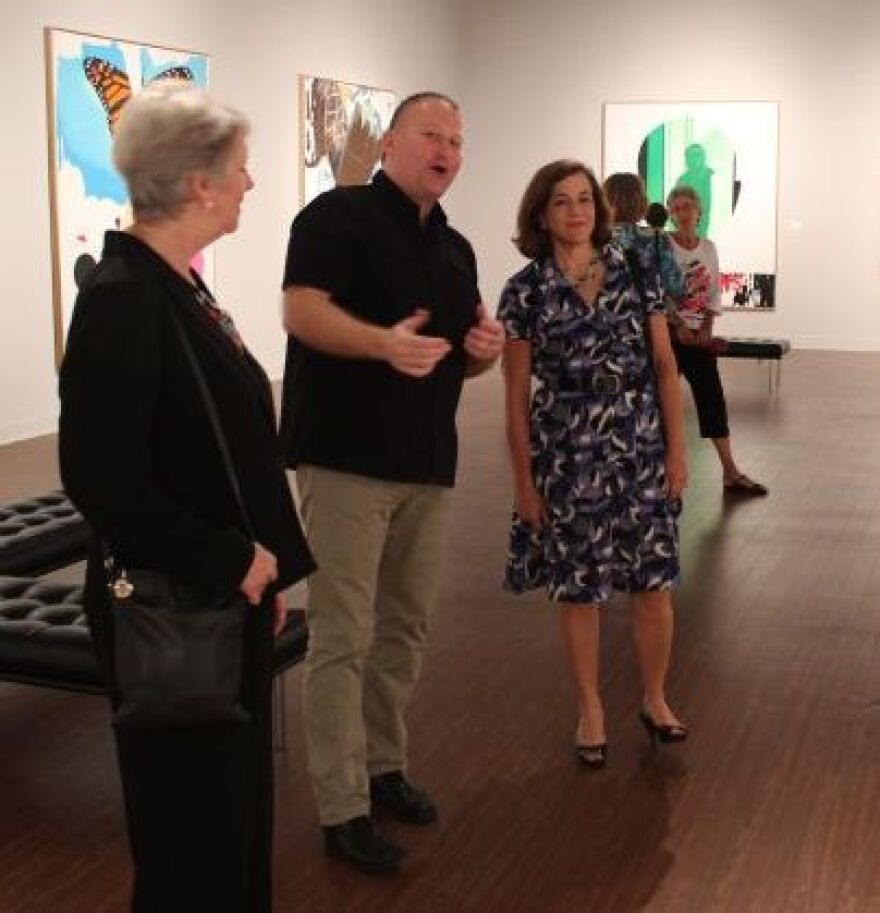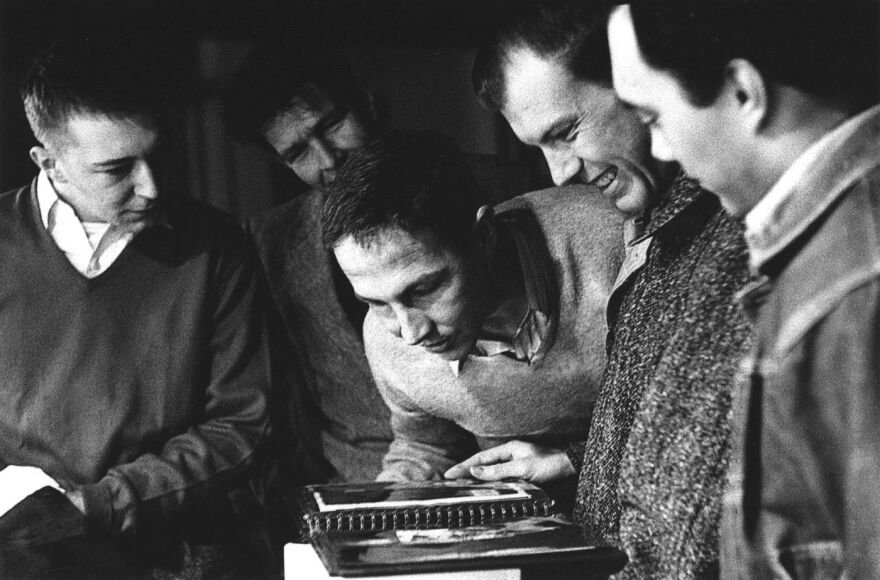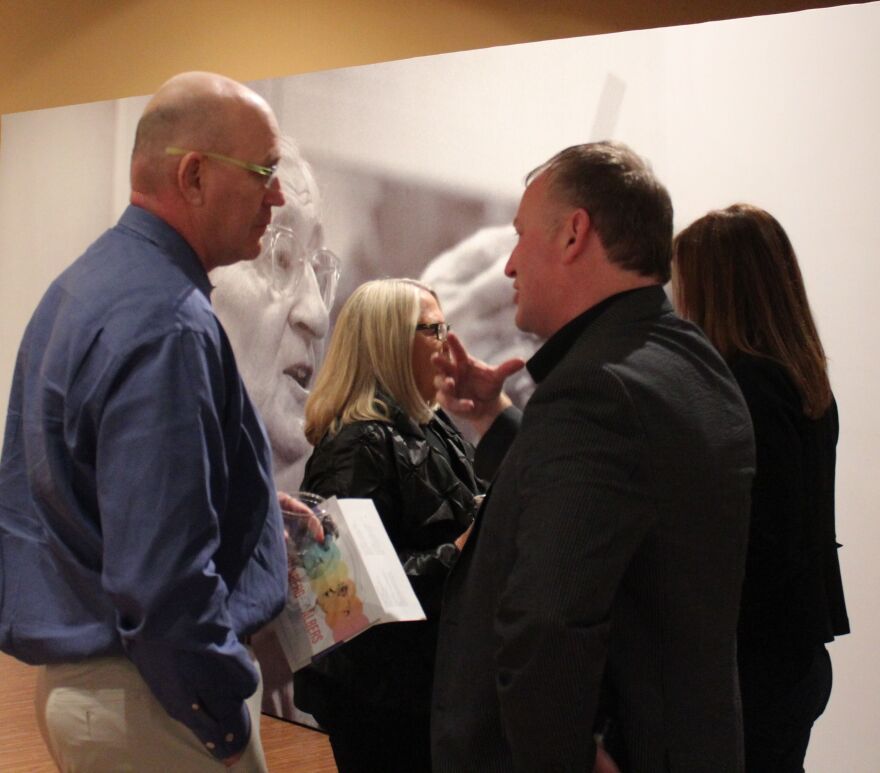Determining an artist’s importance is normally problematic. Not with Robert Rauschenberg. So says Jade Dellinger with the Bob Rauschenberg Gallery in Fort Myers.
“He was an artist’s artist,” Dellinger proclaimed. “Maybe people have heard or know more about Salvador Dalí or Andy Warhol in terms of name recognition, but Rauschenberg is one of those artists that really changed everything. His work was all about that. He was constantly changing.”

He pioneered the incorporation of found objects into paintings and sculpture. He pioneered converting discarded items into lasting works of art. He pioneered silkscreen and transfer solvent printmaking.He pioneered performance art, and his name is synonymous with collaboration. Over the course of his career, he partnered with scientists, composers such as John Cage, dancers such as Merce Cunningham and entire countries during his Rauschenberg Overseas Cultural Interchange. He single-handedly changed the paradigm of the recluse artist working alone in a studio.

“It will become evident in this year, which is his centenary, how important he is, how influential he is,” Dellinger added. “Almost every serious museum around the world owns original works of art by Robert Rauschenberg.”
For those who keep score by auction price, his 1964 silkscreen, “Buffalo II,” sold at Christie’s in 2019 for $88.8 million. But that’s an imperfect rubric by which to measure Rauschenberg’s importance.
“Leading art historians and art writers … have called him the giant of American art, not a giant, and equated him to our Picasso. I would always argue that Rauschenberg is of that importance. He's the most important and influential artist of the second half of the 20th century.”
He was important to Captiva and Fort Myers, too.
“My hope is that we can allow those within our community to take and embrace and understand how deeply connected he was here,” said Dellinger. “In the same way that we celebrate Thomas Edison, Bob Rauschenberg, the most important artist of the second half of the 20th century, lived in our community for more than four decades.”
He didn’t just live here. He put Fort Myers on the world art map, giving his name to the art gallery at Edison State College, now Florida Southwestern State.
“Before the building was built, he was introduced to William Frizzell, the architect, and they worked with the Smithsonian [Institution] to make a proper climate-controlled, high security, with security guard sort of space, the first in Southwest Florida,” Dellinger noted. “He felt so comfortable with it he volunteered to make a solo exhibition in that inaugural season and he made regular exhibitions throughout.”
He debuted some of his most famous artworks at the Bob Rauschenberg Gallery, including “The ¼ Mile or Two Furlong Piece” in three parts over three years. But he also supported local arts organizations.
“He had a relationship, for example, with Arts for ACT and would make some of his artwork available for their annual galleries,” Dellinger noted. “And he would appear and he would bring his famous friends. He brought Sharon Stone. He brought a number of other celebrity friends to help support that cause. There's an autism center locally that he supported regularly. He did lots of things behind the scenes, much less known, but writing checks, helping to support organizations that he believed in.”
Like Thomas Edison, Bob Rauschenberg believed in Fort Myers.
Edison once famously said “There is only one Fort Myers, and 90 million people will find this out.”
Dellinger recalls a favorite Rauschenberg quote of his own.
“He sort of famously said Fort Myers is as small as your mind is. It can be just as large as the world is. It's all about thinking broadly and making work, engaging with the world in ways that can resonate far beyond the local.”

MORE INFORMATION:
Gallery Director Jade Dellinger also placed heavy emphasis on the benefit Rauschenberg conferred on the gallery at FSW when he gave it his name.
“We have the great good fortune of having his name 17 years after his life and that opens up so many possibilities for us.”
It has and continues to enable Dellinger to attract top talent for groundbreaking exhibitions.
Among the headliners who’ve exhibited work at the Bob Rauschenberg Gallery are Yoko Ono (2014, 2017), Jack Massing (2014, 2017), Theo Wujcik (2015), James Franco & Kalup Linzy (2017), Ben Patterson (2017), the Guerrilla Girls (2019) and, most recently, William S. Burroughs & David Bradshaw (2025).

“Although his history here is extraordinary, we're constantly trying to tell that story,” Dellinger said.
Dellinger mentions Rauschenberg in the company of Picasso, Matisse and Duchamp.
“Rauschenberg had the same kind of influence in the second half of the 20th century and into the beginning of the 21st century. There aren't really words to describe how impactful he is.”
For Dellinger, Rauschenberg’s importance transcends the various genres he broke and reconfigured. He forced artists to think about art in entirely new ways.
“Not only was he there and at the forefront, but he also challenged our concepts, our very concepts about art and how it could or should be structured,” said Dellinger. “He was the one that was proposing the way forward.”
An integral part of Rauschenberg’s legacy is his emphasis on artists' need to continually re-invent themselves.
“When he won the Venice Biennale in Venice, Italy, he was the youngest artist, and the first American to win the Venice Biennale, the Golden Lion,” Dellinger noted. “After he won, he called his New York studio and had them destroy all of his screens for making paintings because he didn't want to come back and have the ease of repeating himself and doing something that would undoubtedly have been widely popular. He wanted to have to change everything. He wanted to have to reinvent himself constantly.”

Local Impact
Rauschenberg’s ties to the local community pre-dated Dellinger’s arrival as the Bob Rauschenberg Gallery’s director. The artist’s relationship with the gallery began in 1979.
“He used his studio on Captiva and the gallery here as a laboratory for exhibiting art for the first time, for world premiering art,” Dellinger noted. “While he didn't want people wandering up off the beach and interrupting his work or his day in Captiva, here he could meet and greet people.”

In addition to premiering artworks and exhibitions at Edison State College/FSW, he made prints for both the gallery and the college and supported its programming. But, said Dellinger, giving gallery his name and cachet cemented his local legacy.
“It really allows us an extraordinary opportunity to resonate much more broadly beyond Fort Myers, Lee County,” Dellinger observed. “Having his name is a tremendous honor but also opens many doors.”

The gallery is in the process of memorializing its relationship with the artist in a digital archive.
“There is a good bit that we have online on Rauschenberggallery.com,” Dellinger noted.
“We have all of the exhibitions in the last probably two decades there with every article that has been written about those shows. They're there in PDF form, so can be downloaded. We also have physical archives that are a part of our collection and the college actually, FSW, now that we're based in the library on the ground floor here, the college is working on creating a digital commons.”

In addition to supporting Arts for ACT and a number of other local arts organizations, Rauschenberg also supported area galleries and artists.
Dede Sweet owns and operates Sweet Art in Naples. She tells the story of how Rauschenberg stopped at her gallery on his way to a Christmas party. It was her grand opening, and she did not actually have her certificate of occupancy yet. As he came through the door, he bellowed, “Who owns this gallery?” and then chided her for not inviting him to the opening. “No one ever opens a gallery without inviting me.”
Sweet didn’t know who he was, and the artist gave her a fake name, simply adding that he was a collector. He was that sort of guy. Read the full story of Sweet’s encounter with Rauschenberg here.

Rauschenberg also anonymously helped artists who were experiencing financial challenges.
“As soon as Bob began to make money, he set up a company called Change Incorporated,” Dellinger noted. “Change Incorporated was set up as a means to help artists who were experiencing some emergency. So even dating back to the very earliest of the 1960s, if an artist sent him a note or wrote him a letter and said we've had a studio fire, I've lost everything, he would send them money.”
Photographer William Wegman was once the recipient of Rauschenberg’s largesse.
“He told me the story of his having had literally a fire and Bob moved him into 381 Lafayette, into his building, and gave him money to support him after he lost his studio. He was just a young artist at the time.”
Wegman paid that forward by exhibiting his work in a solo show at the gallery “because of his love and respect for Bob.”
“Bob was always incredibly supportive of other artists, not just those in need, but also to help promote them,” Dellinger added. “He’d often buy their work or arrange for them to exhibit either here at the gallery or elsewhere.”

Dellinger expects to hear many such stories as he travels the state commemorating Bob Rauschenberg’s centenary … and extending his legacy.
Support for WGCU’s arts & culture reporting comes from the Estate of Myra Janco Daniels, the Charles M. and Joan R. Taylor Foundation, and Naomi Bloom in loving memory of her husband, Ron Wallace.







